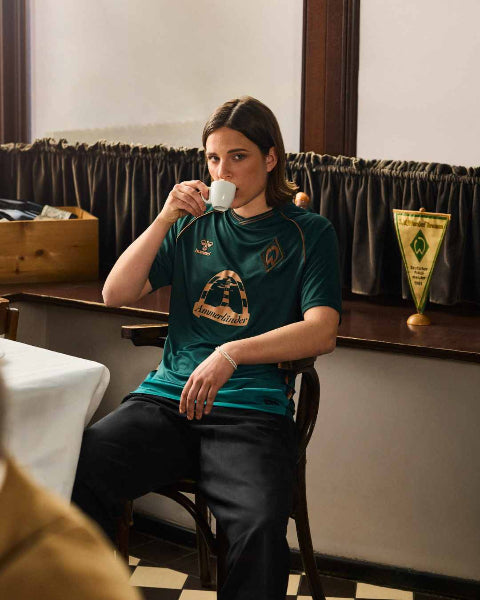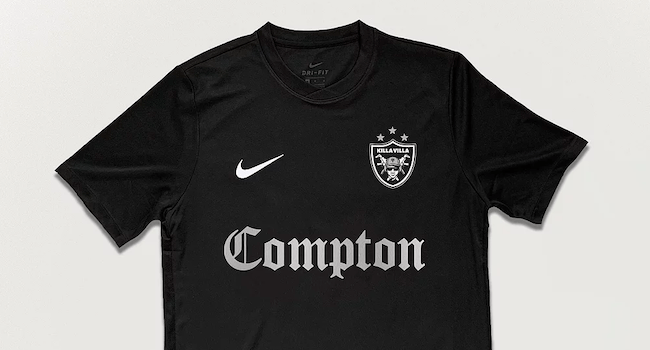Recently added
Vintage shirts
Concept kits
Legends
Saints, Students, and Jesuit Priests: Southampton in the Andes
by Mike Maxwell February 05, 2022 6 min read

Amid Venezuela’s highest peaks, which form part of the longest mountain range in the world, The Andes, is the city of Mérida. The Pico Bolívar, named after Venezuelan independence hero Simón Bolívar, penetrates the clouds to the tune of 4,978 metres and is the country’s highest point. Less than 21 kilometres from the summit is the Estadio Guillermo Soto Rosa. At 1,400 metres above sea level, the Soto Rosa is Venezuela’s most elevated football stadium, and it has played host to some of Venezuelan football’s most memorable games and one of its most historic clubs, Estudiantes de Mérida.

Founded in 1971 off the back of a successful amateur side that was dominating state championships with an ensemble of students, Estudiantes were one of the first teams to challenge the hegemony of Venezuela’s colonial clubs. Although the first game of football to be played in the Latin American country happened 144 years ago, the early professional game was characterised by émigré sides representing settled European communities, most notably Portugal, Spain, and Italy. The year before the Soto Rosa was constructed in 1969, the nine-team Venezuelan topflight was won by Unión Deportiva Canarias, who pipped Deportivo Italia to the title by three points, who in turn were just one point ahead of CD Portugués. That year, Brazilian Raimundinho was the league’s top scorer, and in the preceding 11 seasons, a Venezuelan had finished top of the scoring charts just twice.
The colonial supremacy eventually passed, although its legacy has endured, and in its place rose the likes of Caracas FC, Atlético Zamora, Deportivo Táchira, and Estudiantes (the latter two forming the great Clásico Andino derby), all of which were formed within seven years of each other, between 1967 and 1974. Although Estudiantes does not boast as many titles as the other three, along with neighbouring club Universidad de Los Andes FC (ULA), their place in the country’s football history is of vast importance. Today, Mérida symbolises the Venezuelanness of Venezuelan football.

Having led La Vinotinto out of the group stage for the first time in history when they hosted the competition in 2007, Páez stepped down, but not before he ensured a lasting legacy more powerful than that of the colonial clubs.

Firstly, in the same year that he resigned, he convinced the Venezuelan Football Federation to introduce a rule known as the Juvenil de la Norma, which stipulates that every Venezuelan side must have at least one U-20 player fielded at all times, and secondly, in 1993, he had founded Academia Emeritense, a football academy in Mérida, set up to espouse and evolve his footballing philosophy throughout the state’s fledgling young players.
As of 2020, the Juvenil de la Norma rule has aided the national team’s greatest ever successes at youth level in both the men’s and the women’s game – most notably the men’s U-20s runners-up finish at the 2017 World Cup, and unbeaten consecutive South American Championships for the women’s U-17 side – and Academia Emeritense has grown into a state of the art facility that boasts international titles from youth tournaments around the world and over 450 young players on its books. Yet for all Páez’s pure and patriotic desires for Venezuelan football, even he and his city have foreign influences to thank; perhaps most curiously Southampton Football Club.

Before embarking on his proselytising career that would culminate in the conversion of a traditionally baseball nation, Páez was indoctrinated into football as a child by Jesuit fathers at the Colegio Gonzaga de Jesuitas in Maracaibo - Jesuits being members of the Society of Jesus, a religious order within Catholicism, founded by a Spaniard nearly 500 years ago. At the age of 18, Páez began studying Medicine at the Universidad de Los Andes, balancing his academic pursuits with his footballing interests. It was at this point in his life that his path would merge with that of Estudiantes, winning the 1970 Youth Championship with the amateur side that preceded the professional club. Thanks to the efforts of former pupils of the local school – also Jesuit - San José, many of whom were playing for the team, Estudiantes de Mérida was formed on 4 April 1971.
Their first game came six months later and finished in a 2-1 victory over the now defunct – and aforementioned – CD Portugués. Estudiantes were decked out in red and white stripe. The colours were a natural pick, taking inspiration from the San José kits many of them had once worn for their school team. In turn, San José’s colours and design were a nod to the school’s heritage.
The Catholic Jesuits who ran the school had come to the Andean mountain city from the Spanish port city of Bilbao, and thus many were fans of its team, Athletic Club. Famous for their fiercely stringent transfer policy, which dictates that they only sign and field players from the Basque Country (of which Bilbao, although not the capital, is its biggest city, and is similarly in the shadows of a mountain range), the club owes its colours to Southampton FC.

Since 1902, Athletic Club had been playing in the shirts of Blackburn Rovers, but in 1910, a student from Bilbao named Juan Elorduy was unable to buy more when tasked during a trip to England. On his return home, travelling by ship from Southampton, he improvised and bought “50 shirts from Southampton Football Club”, who had been wearing red and white stripes with blue shorts since 1896, the year in which they changed their name from Southampton St. Mary’s, having started out in 1885 as St Mary’s YMA in white shirts with red sashes, white shorts, and black socks. With red and white playing the prominent role in the crest of Bilbao and the early form of the club itself containing founding members from Southampton, it was a fitting compromise.
From then on, the Basque side adopted the red and white stripes of the Saints – as did Atlético Madrid, who had begun life as a youth branch of Athletic Club – and 61 years later, thanks to members of Bilbao’s Jesuit congregation, they became the colours of Estudiantes de Mérida. Curiously, while Athletic Club seemed to opt for a swap to white shorts (and socks) almost immediately - and then latter black - it wasn’t until 1950 that Southampton made a change, only deviating from black in three of the 70 years since. Estudiantes, on the other hand, stayed true to tradition, playing in blue shorts to this day – as do the other indirect inheritors of England’s premier south coast club, Atlético Madrid.
Within a year of Athletic Club’s red and white history beginning, their famous transfer policy began – a curious move for an institution founded through a merger with a club formed by Englishmen (Bilbao FC), but unsurprising given the fierce identity and politics of the Basque Country. The decision has made Athletic Club heavily reliant on its academy, in a similar vein to Southampton, but far more extreme, and – given its impact on the creation of Estudiantes – perversely influential on its Venezuelan counterparts. Through Páez’s championing of Venezuela’s creole and native talent and the formation of his family’s own academy, Estudiantes are becoming the Athletic Club of the Andes and the Southampton of the Sierra Nevada de Mérida. Identifying, developing, and providing Venezuela’s own Gareth Bales and Fernando Llorentes is Academia Emeritense. While the similarities are many, that first bond tying the three clubs together will always be the red and white stripes.
To date, Andrew Páez, whose wife Sara is the academy’s president, says around fifty players who have graduated through their ranks have gone on to play for Estudiantes, including nine current first team players. Like Southampton, whose conveyor belt of talent seems to have rusted recently, and Athletic Club, who have had to ever so slightly relax their eligibility criteria, Estudiantes may not be able to rely on Academia Emeritense for much longer. They now have their own senior team which plays in the Venezuelan third tier and have every intention to join Estudiantes in the top flight.
In 2007, Estudiantes left the Soto Rosa after 36 years for the newly built Estadio Metropolitano de Mérida. Constructed for that year’s Copa América, the 42,500-capacity stadium was one of nine venues either built or renovated in order for Venezuela to host the competition. Six days before it began, La Vinotinto played their final warmup game. In the dugout was of course Richard Páez. And who had he welcomed to face his side? Playing their first game outside of Spain in 69 years was the Basque Country.
By Jordan Florit, author of the first English Language book on Venezuelan football, Red Wine & Arepas: How Football is Becoming Venezuela’s Religion.
You can follow Jordan on Twitter at @TheFalseLibero, and if you liked this article, Jordan runs a Twitter account dedicated to Venezuelan football, @FUTVEEnglish.

Mike Maxwell
Mike is the founder FSC in 2012, and grew it from a blog, to the marketplace it is today. Alongside the day to day running of the business, Mike is always on the look out for new vintage shirts and modern classics to add to our store!
Leave a comment
Sidebar
- Premier League football shirts
-
Other English clubs
- Birmingham City
- Blackburn Rovers
- Charlton Athletic
- Coventry City
- Derby County
- Hull City
- Ipswich Town
- Leicester City
- Middlesbrough
- Millwall
- Norwich City
- Portsmouth
- Preston North End
- Queens Park Rangers
- Sheffield United
- Sheffield Wednesday
- Southampton
- Stoke City
- Swansea City
- Watford
- West Bromwich Albion
- Scottish clubs
- Italian club shirts
- Spanish club shirts
- German club shirts
- International
- French club shirts
- Rest of the world
-
Legends
- Adriano
- Alessandro Del Piero
- Andrey Arshavin
- Alvaro Recoba
- Bobby Moore
- Bryan Robson
- Bukayo Saka
- Clarence Seedorf
- Cristian Vieri
- Cristiano Ronaldo
- David Beckham
- David James
- David Seaman
- David Ginola
- Dennis Wise
- Dennis Bergkamp
- Didier Drogba
- Dimitar Berbatov
- Diego Maradona
- Edgar Davids
- Eric Cantona
- Fernando Torres
- Freddie Ljungberg
- Gabriel Batistuta
- Gianluca Vialli
- Gianluigi Buffon
- Giovanni Elber
- Frank Lampard
- Francecso Totti
- Haaland
- Harry Kane
- Hidetoshi Nakata
- Ian Wright
- Jari Litmanen
- Ji Sung Park
- Juninho
- Jurgen Klinsmann
- Kaka
- Landon Donovan
- Lionel Messi
- Lothar Mattaus
- Luis Figo
- Mark Viduka
- Matt Le Tissier
- Mesut Özil
- Michael Owen
- Mikel Arteta
- Neymar
- Nicolas Anelka
- Nwankwo Kanu
- Paolo Di Canio
- Paolo Maldini
- Patrick Vieira
- Rafael Van der Vaart
- Raul
- Riquelme
- Rivaldo
- Robert Pires
- Roberto Baggio
- Robbie Fowler
- Ronaldo Nazario
- Ronaldinho
- Roy Keane
- Rudi Voller
- Ruud Gullit
- Ryan Giggs
- Santi Carzola
- Steve Bull
- Steven Gerrard
- Teddy Sheringham
- Thierry Henry
- Tony Adams
- Toto Schillaci
- Tugay
- Wayne Rooney
- Xabi Alonso
- Zinedine Zidane
- Zola
- Brands
Subscribe
Sign up to get the latest on sales, new releases and more …













